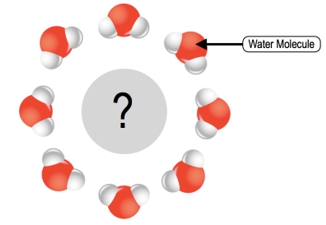In this video, we're going to continue talking about the properties of water, specifically how water can act as the universal solvent. Now water is described as the universal solvent because water is capable of dissolving so many different types of solutes. We need to differentiate between the term solvent and solutes. The solvent is defined as the substance that does the dissolving and is usually found in larger amounts. When referring to life, the solvent is usually water itself. Because water can dissolve so many different types of biological molecules, we call it the universal solvent.
The solute, on the other hand, is defined as the substance that gets dissolved by the solvent. Usually, the solute is found in much smaller amounts. If we look at our image below at our example, we can differentiate between the solvent and the solute. We're looking at an example of table salt, &#xNaCl; (sodium chloride), being dissolved in water. Notice on the left here we have our sodium chloride, the table salt, and on the right we have the sodium chloride being poured into our water.
On the left-hand side, when we're just looking at the table salt, recall that it's made up of sodium chloride molecules. The sodium chloride molecules form ionic bonds between the sodium cation, which is positively charged, and the chloride anion, which is negatively charged. There is an intact ionic bond forming between these two ions. However, when we take the table salt and dissolve it into the water, what you'll notice is that the ionic bonds are being disrupted. The sodium cation is not capable of forming an ionic bond with the chloride anion mainly because the water molecules surrounding them are disrupting the potential for them to form ionic bonds.
Notice that the water here is what is doing the dissolving. The water is going to be found in larger amounts; it's what's doing the dissolving, making the water the solvent. Of course, this means that the solute is going to be the sodium chloride. When we take the combination of all the solutes and the solvent, what we get is the solution. The solution is the combination of the solute and the solvent. Because water is acting as the solvent, we call this an aqueous solution. An aqueous solution is a solution in which water acts as the solvent.
Also, notice that the water molecules in the solution form what's known as a hydration shell around the dissolved solute molecules. When we take a look at the dissolved solute molecules, the sodium and the chloride, notice that they are being surrounded by a hydration shell. This shell is when water molecules surround the substance and interact with the substance to dissolve them.
This here really concludes our introduction to the lesson on how water acts as the universal solvent and can dissolve so many different types of solutes. Moving forward in our course, we'll talk about how water can dissolve most of the biological molecules that we'll discuss, such as proteins, nucleic acids, and carbohydrates. This concludes our lesson, and we'll be able to get some practice applying these concepts in our next few videos. So, I'll see you all there.


